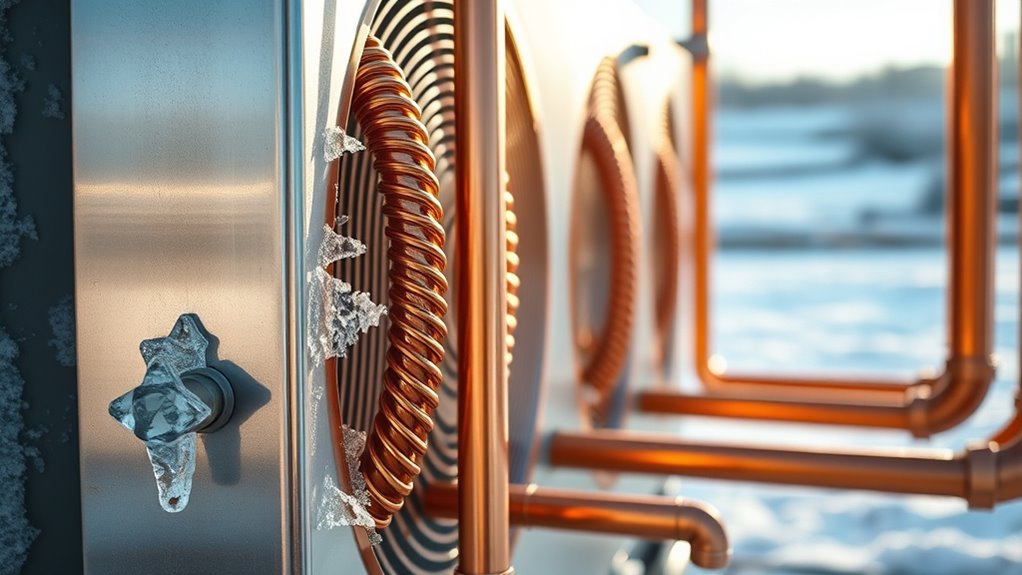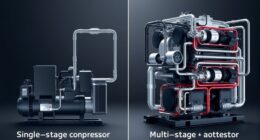The thermodynamic limit of heat pumps is set by Carnot efficiency, which defines the maximum possible performance based on the temperature difference between reservoirs. While ideal systems reach this limit, real heat pumps experience losses due to material imperfections, environmental factors, and operational constraints. These factors reduce efficiency and reliability. By exploring how these limits compare and what innovations are emerging, you’re on a path to understand how future technologies aim to close the gap.
Key Takeaways
- Carnot efficiency sets the maximum theoretical performance for heat engines and heat pumps operating between two temperature reservoirs.
- Real heat pumps cannot reach Carnot efficiency due to material imperfections, irreversibilities, and operational constraints.
- Efficiency of actual devices declines at lower outdoor temperatures and varies seasonally, unlike the constant maximum of Carnot cycles.
- Practical limitations include refrigerant properties, system maintenance, and environmental factors that reduce real-world performance.
- Innovations aim to minimize entropy generation and close the gap between practical efficiencies and the thermodynamic Carnot limit.
The Concept of Carnot Efficiency

The concept of Carnot efficiency defines the maximum possible efficiency that any heat engine can achieve operating between two temperature reservoirs. By performing an entropy analysis, you see that the cycle efficiency depends solely on the temperatures of these reservoirs, not on the engine’s details. The Carnot cycle, which is ideal and reversible, sets this upper limit. During the cycle, entropy increases in the cold reservoir and decreases in the hot reservoir, but total entropy remains constant in a perfect process. This balance ensures maximum cycle efficiency, meaning no real engine can surpass this theoretical limit. Understanding this principle helps you grasp how thermodynamic constraints govern real heat engines and emphasizes the importance of entropy in evaluating efficiency. Additionally, this concept highlights the significance of entropy in determining the fundamental limits of energy conversion processes.
Derivation of the Carnot Cycle
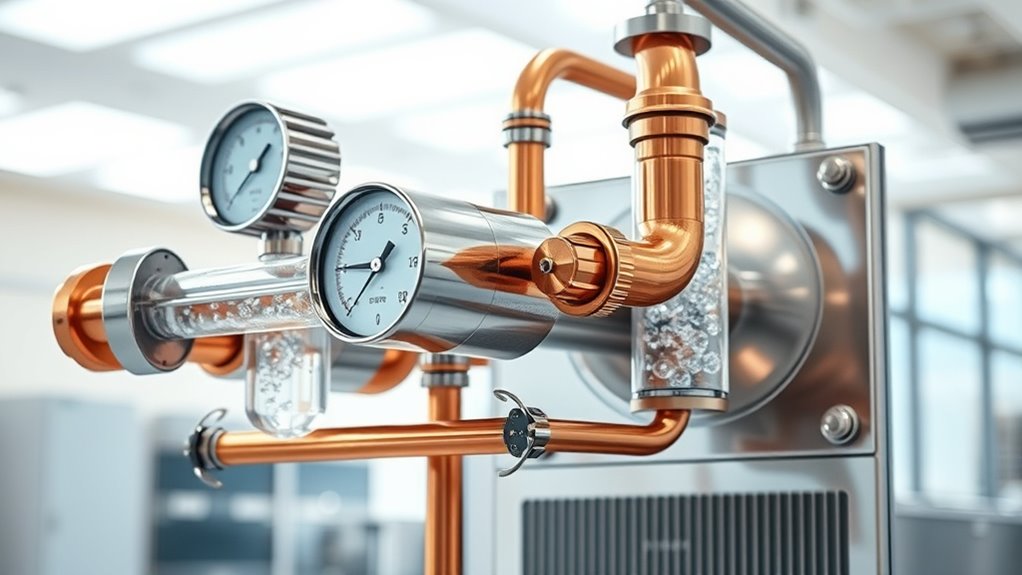
To understand how the Carnot cycle achieves its maximum efficiency, it’s important to examine how it is derived from fundamental thermodynamic principles. The cycle is built on four reversible processes: two adiabatic and two isothermal. Reversible processes ensure no entropy generation, meaning the system operates without increasing entropy in the surroundings. During the isothermal expansion and compression, heat is exchanged with reservoirs at constant temperatures. The adiabatic steps change the temperature without heat transfer. This idealization allows the cycle to operate with maximum efficiency, as any entropy generation would reduce it. By carefully analyzing these processes, you see how the cycle’s reversibility and temperature differences define its limits, laying the foundation for understanding the theoretical maximum efficiency of heat engines. Additionally, the concept of entropy plays a crucial role in determining the efficiency limits of real and idealized heat engines.
Limitations of Real Heat Pumps
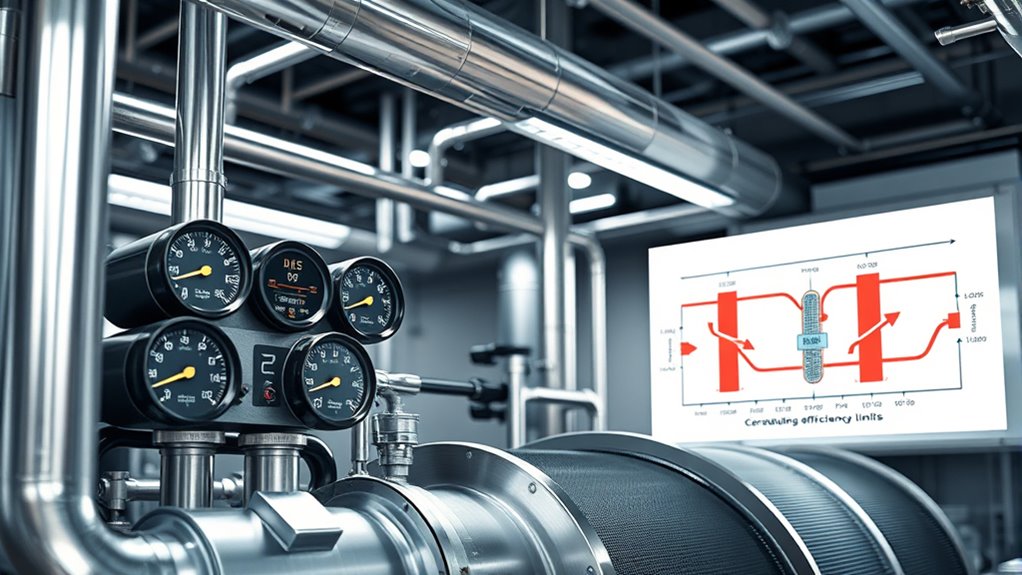
While heat pumps are designed to transfer heat efficiently, real-world limitations prevent them from reaching ideal performance levels. One challenge is refrigerant toxicity; some refrigerants pose health risks if leaks occur, requiring careful handling and safety measures. Additionally, noise pollution can be a problem, especially with older or poorly maintained units that produce loud operational sounds, disrupting comfort and tranquility. These factors can limit the deployment and usage of heat pumps in residential areas. Furthermore, efficiency drops due to environmental conditions, such as extremely cold weather, further hindering performance. The presence of smart features can help optimize operation but may also introduce complexity and potential security concerns. While technological advances continue, these limitations remind you that, despite their benefits, real heat pumps face practical constraints that affect their overall effectiveness and safety.
Factors Affecting Heat Pump Performance
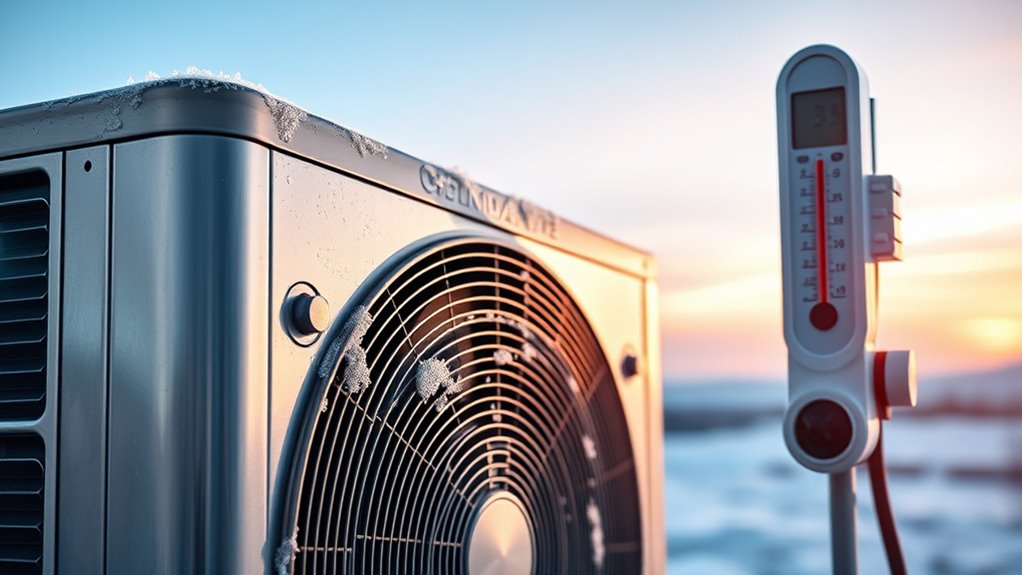
Your heat pump’s performance depends on several key factors. Changes in outdoor temperature, refrigerant properties, and system efficiency directly affect how well it works. Understanding these influences helps optimize operation and energy savings. Additionally, advancements in heat pump technology, such as variable-speed compressors and smart thermostats, further enhance performance and efficiency.
Ambient Temperature Impact
How does ambient temperature influence heat pump performance? The ambient temperature plays a pivotal role in how efficiently your heat pump operates. When outdoor temperatures are higher, the heat pump can extract heat more easily, improving efficiency and reducing energy consumption. Conversely, lower ambient temperatures mean the pump has to work harder, decreasing performance and increasing energy use. This environmental impact affects not only your energy bills but also the overall effectiveness of your heating or cooling system. Understanding this relationship helps you anticipate seasonal variations and select systems suited for your climate. Keep in mind, as ambient temperatures fluctuate, they directly influence the thermodynamic limits of your heat pump, shaping its capacity to meet your comfort needs efficiently. Additionally, seasonal energy efficiency ratings like SEER can vary with temperature changes, impacting overall system performance.
Refrigerant Properties Influence
Refrigerant properties are essential in determining a heat pump’s efficiency and capacity. Selecting the right refrigerant impacts how effectively the system transfers heat and operates under various conditions. You need to consider properties like boiling point, specific heat, and pressure-temperature relationships for property optimization. The table below summarizes key refrigerant characteristics:
| Property | Impact on Performance | Example Refrigerants |
|---|---|---|
| Boiling Point | Influences evaporation and condensation | R-410A, R-134a |
| Specific Heat | Affects heat transfer capacity | R-22, R-32 |
| Pressure-Temperature | Determines system operating limits | R-404A, R-1234yf |
| Latent Heat | Impacts energy transfer efficiency | R-410A, R-407C |
| Compatibility | Ensures system durability | R-134a, R-32 |
Additionally, understanding the thermal properties of refrigerants helps optimize system performance across different climates and operational conditions.
System Efficiency Factors
Several factors influence the efficiency of a heat pump, determining how well it transfers heat and consumes energy. Variations in outdoor temperatures, refrigerant selection, and equipment quality directly impact energy efficiency. Proper system optimization involves ensuring components are correctly sized, maintained, and calibrated. Insulation, airflow, and duct design also play essential roles in minimizing energy loss. When these factors are optimized, your heat pump performs more efficiently, reducing energy use and operating costs. Additionally, advanced controls and regular maintenance help sustain peak performance. Understanding these system efficiency factors enables you to maximize your heat pump’s capabilities, ensuring reliable heating or cooling while conserving energy. Focused system optimization not only improves comfort but also extends equipment lifespan and lowers overall energy bills. Incorporating Hybrid Bicycles as a model for adaptable systems can provide insights into versatile and efficient performance.
Comparing Ideal and Practical Devices
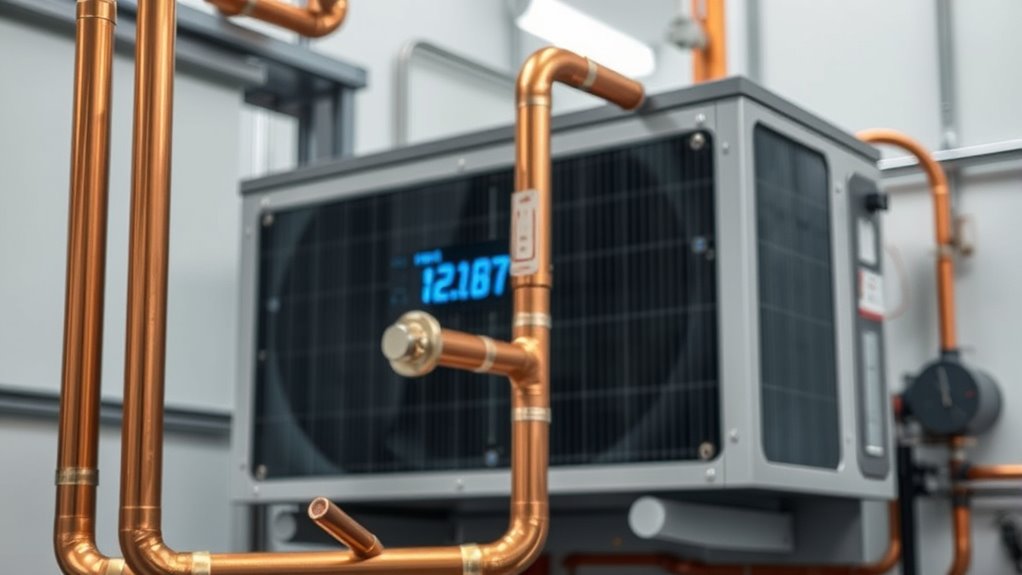
Have you ever wondered why real devices rarely perform as efficiently as their ideal counterparts? The gap stems from reliability challenges and cost considerations. Practical devices face issues like material imperfections and wear, reducing efficiency. They also involve higher costs for maintenance and quality parts, limiting performance. To illustrate, here’s a comparison:
| Aspect | Ideal Device | Practical Device |
|---|---|---|
| Reliability | Perfect, no failures | Susceptible to wear and failure |
| Cost | Minimal, optimized design | Higher due to materials and upkeep |
| Efficiency | Near theoretical maximum | Lower due to real-world constraints |
| Performance | Consistent, predictable | Variable, affected by conditions |
Additionally, real heat pumps often experience performance losses due to thermal resistance and other physical limitations.
Innovations to Approach Theoretical Limits
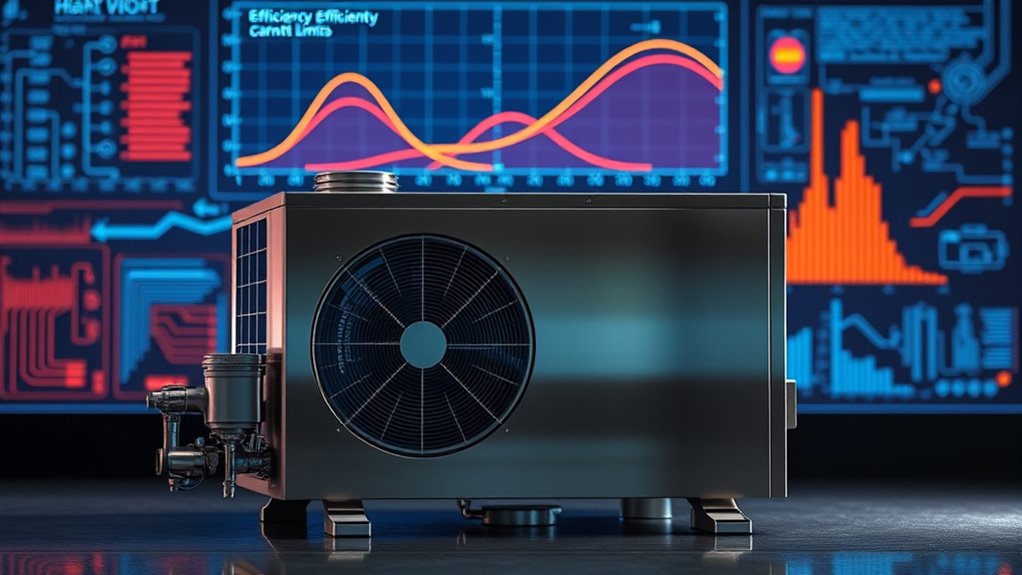
To bring real devices closer to their theoretical limits, researchers are developing innovative materials, advanced manufacturing techniques, and smarter system designs. One key approach involves optimizing phase change processes, which can improve heat transfer efficiency and reduce energy losses. By selecting materials with tailored phase change properties, you can minimize entropy generation during thermal cycles, leading to lower irreversibility. Additionally, integrating advanced manufacturing allows for more precise component fabrication, reducing gaps and imperfections that contribute to entropy production. Smarter system designs incorporate feedback controls and adaptive operations, further limiting entropy generation and enhancing overall performance. Material optimization helps bridge the gap between practical devices and their ideal thermodynamic limits, enabling more efficient heat pumps and refrigeration systems that approach Carnot efficiency more closely.
Future Directions in Thermal Energy Management
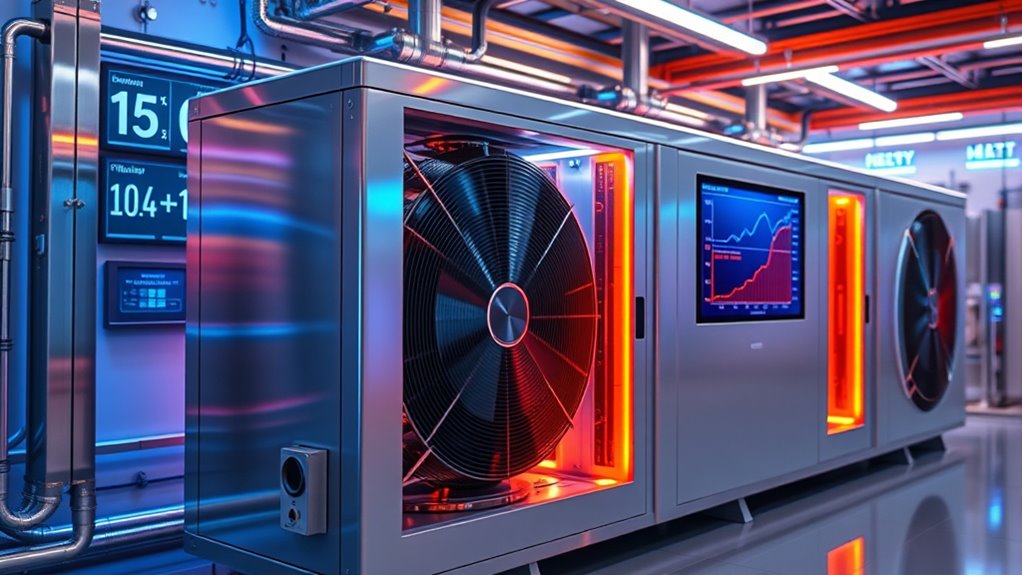
Looking ahead, advancements in material innovations will be key to improving thermal management efficiency. Integrating hybrid systems can optimize energy use across different environments and applications. Embracing sustainable energy solutions will guarantee these technologies remain environmentally responsible and economically viable. Additionally, exploring energy-efficient materials can further enhance the performance and longevity of heat pump systems.
Advanced Material Innovations
As researchers push the boundaries of thermal energy management, innovative materials are emerging to meet the demands of next-generation technologies. Phase change materials (PCMs) are gaining attention because they can absorb or release large amounts of heat during melting and solidification, enabling efficient thermal regulation. Additionally, advances in materials with high thermal conductivity improve heat transfer rates, reducing energy losses in systems like heat exchangers and cooling devices. These materials are tailored to optimize thermal performance, allowing for more compact, responsive, and energy-efficient solutions. By combining phase change properties with enhanced thermal conductivity, engineers develop smarter thermal management strategies that can adapt to dynamic conditions. These innovations pave the way for more sustainable, high-performance thermal systems in various applications.
Hybrid System Integration
How can integrating multiple thermal management systems create smarter, more adaptable solutions? By leveraging thermal coupling and energy integration, you can optimize overall system efficiency. Combining different heat sources and sinks allows for better control over temperature regulation, reducing waste and improving performance. Hybrid system integration enables you to dynamically adjust to varying demands, utilizing the strengths of each component. For example, integrating renewable energy sources with conventional heat pumps can maximize energy use while maintaining stability. This approach not only enhances reliability but also minimizes energy losses. As you design these systems, focus on seamless thermal coupling to ensure efficient heat transfer. Overall, hybrid integration paves the way for smarter, more resilient thermal management solutions that adapt to complex energy landscapes.
Sustainable Energy Solutions
Integrating multiple thermal management systems lays the groundwork for developing sustainable energy solutions that meet future demands. By combining renewable energy sources with advanced energy storage, you can create more reliable and efficient systems. Renewable integration reduces reliance on fossil fuels and lowers emissions, while energy storage ensures consistent power delivery despite variable generation. These solutions enable you to balance supply and demand, optimize system performance, and enhance grid stability. Emphasizing thermal management improves the efficiency of energy conversion and distribution processes. As technology advances, adopting integrated approaches will be essential for achieving sustainable, resilient energy infrastructures. You can help lead the progression toward cleaner energy by designing systems that seamlessly incorporate renewable sources and robust storage options.
Frequently Asked Questions
How Do Environmental Conditions Influence Carnot Efficiency?
You might wonder how environmental conditions impact Carnot efficiency. When ambient temperature rises, your heat engine’s maximum efficiency drops because the temperature difference between heat source and sink decreases. Higher humidity levels can also affect energy transfer, making processes less efficient. So, as environmental conditions like ambient temperature and humidity fluctuate, they directly influence the maximum achievable efficiency of heat engines and heat pumps, reducing their overall performance.
Can Heat Pumps Surpass the Carnot Efficiency Under Real Conditions?
You might wonder if heat pumps can beat Carnot efficiency under real conditions. In practice, they can’t surpass this limit because Carnot efficiency is based on idealized models and reversible cycles that define the maximum theoretical performance. Real heat pumps operate with irreversibilities and practical constraints, so they stay below the Carnot limit. While advancements improve efficiency, exceeding this fundamental thermodynamic boundary isn’t possible in real-world applications.
What Materials Are Most Effective in Improving Heat Pump Limits?
You should focus on material selection and phase change properties to improve heat pump limits. Using refrigerants with ideal phase change characteristics enhances efficiency by transferring heat effectively. Advanced materials like nanostructured composites or eco-friendly refrigerants with better thermal conductivity can boost performance. By choosing materials that facilitate efficient phase change, you enable your heat pump to operate closer to its theoretical limits and improve overall energy efficiency.
How Does Entropy Generation Impact Real Heat Pump Performance?
You might notice that entropy generation reduces a heat pump’s efficiency. When entropy production occurs due to system irreversibility, it causes energy losses, meaning less heat transfer and higher operational costs. These irreversibilities, like friction or uncontrolled heat transfer, make the system less effective. Managing entropy generation involves minimizing irreversibilities, which boosts performance and helps the heat pump operate closer to its ideal efficiency.
Are There Economic Trade-Offs in Pursuing Near-Ideal Efficiencies?
You should consider that pursuing near-ideal efficiencies involves economic trade-offs. A thorough cost-benefit analysis helps determine if the higher initial investment and operational costs are justified by improved performance. Technological feasibility also plays a role; some advanced systems may be too complex or costly to implement effectively. Balancing these factors guarantees you optimize performance without overspending, making the pursuit of efficiency practical and economically sound.
Conclusion
Understanding Carnot efficiency shows you the ultimate ceiling of heat pump performance, but real-world devices rarely reach this mythic peak. Limitations like friction, material imperfections, and energy losses act like stubborn clouds blocking the sun’s brilliance. Yet, ongoing innovations ignite hope that we can inch closer to these cosmic limits, transforming thermal management from a distant dream into a blazing reality. Keep pushing boundaries—soon, you’ll harness energy like a master alchemist turning heat into gold.
